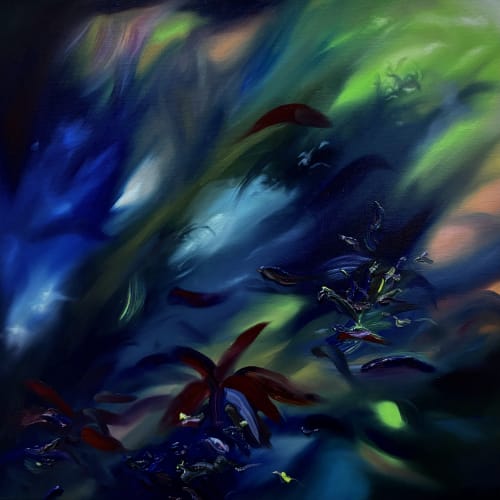Sanderson are pleased to announce the exhibition Moon Sown by Molly Timmins.
Molly Timmins (Ngāpuhi, Pākehā, b.1998) is a painter based in Tāmaki Makaurau Auckland. Her work explores gardens as both an environmental physical place, and a painted subject throughout art history. Timmins completed a Master of Fine Arts at Whitecliffe College of Arts in 2023. She was the winner of the Upstairs gallery Emerging Art Award (2019) and has been a finalist in other numerous awards in Aotearoa including the Eden Arts Award, Nelson Emerging Artist Awards, Parkin Drawing Prize and the Molly Morpeth Canaday Awards. In 2024, Timmins was the recipient of the Early Career Fund - Toi Tipu Toi Rea from Creative New Zealand, which acknowledges and supports practitioners at the early stage of their career. The works in this exhibition have been made utilising this support.
Breathing in the Garden After Dark by Dina Jezdić
In Māori cosmology, Te Pō is the original night. It is not a void. It is a space of beginnings: a place of waiting, transformation, and becoming. Te Pō is where whakapapa comes into view; where lineage, memory, and the long thread between the living and those who came before are made visible. It is where knowledge rests before it is spoken.
In Moon Sown, Molly Timmins paints the garden as it is shaped by the night and its quiet influence - the thickened air, the softened light, the sense that something is stirring beneath the surface. Her work sits inside the garden like memory; stretching, absorbing and reflecting. Under te marama, the moon, the garden sharpens, and leans toward its own rhythms; enabling growth in the deep hours, where the night holds the shape of what is yet to come.
Timmins approaches painting as an act of close observation, much like early botanists who studied plants to understand and classify them. Unlike these early scientists, however, the artist welcomes ambiguity, allowing the paint to suggest botanical forms without settling into fixed shapes. At the same time, she highlights material histories by bringing oil paint and embroidery into conversation on the canvas. An ecology emerges where endemic plants mingle with introduced bromeliads, reflecting matrilineal memory intertwined with the enduring impacts of colonialism. In Timmins’ hands, the moon and the garden merge through atmosphere. Moving across the canvases with a presence, both deliberate and intuitive, the shimmering reflection of the moon is captured by the water held within the heart of the bromeliad.
Ngāpuhi and Pākehā whakapapa form the foundation of this practice, their threads reaching deep into the soil of identity. On Timmin’s mother’s side, a lineage of bromeliad growers carries the story of introduced plants that were once seen as exotic but now embody the complexity of intertwined histories and ancestry. Her father’s whakapapa traces back to tūpuna Moengaherehere, one of the original signatories of Te Tiriti o Waitangi. This lineage holds ancestral stories deeply rooted in the whenua, weaving connections across generations. Tension gathers between these inherited worlds, yet Timmins does not seek to resolve it; instead, she lets these strands braid, overlap, and take root within her practice.
Here, emotional labour takes root—the often invisible work of managing feelings. For those living between settler and tangata whenua identities, softening impact and adjusting presence to maintain balance is ongoing work. Timmins’ paintings carry this weight. Each brushstroke and stitch seem to ask: What weight do I carry? These works give form to the unseen labour of softening anger, absorbing silence, holding grief just long enough to allow something new to grow.
Gardens have never been only about beauty. They have been sites of survival, prayer, and power. In ancient Persia, they were designed as earthly visions of paradise. In Renaissance Europe, they imposed control through symmetry and order. Under colonial rule, gardens became instruments of empire, where botanical collections catalogued and displaced plant life; asserting ownership over land and knowledge. Even the suburban backyard, edged with lawn and lavender, inherits this legacy of control. In Moon Sown, the garden is reclaimed. Timmins paints it as a living, layered space where plants grow in relation to each other, to ancestry, and to what remains unseen. A gesture toward what else a garden might hold.
Moon Sown is a field of atmospheres. It is a living archive of matrilineal care, emotional knowledge, and the layered weight of inheritance. Like water held in the heart of a bromeliad, these works carry more than they reveal. They sustain ancestral tides, the hush of nocturnal rain, and the invisible labour of tending. Like the moon pulling at the sea, Timmins draws us toward another way of sensing. A way attuned to land and to lineage, where memory waits in the dark, like a seed before the dawn.
By Dina Jezdić, July 2025

